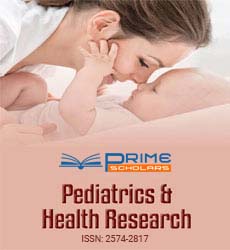Short Communication - (2023) Volume 8, Issue 4
Dysphagia Leads to Chronic Pulmonary Aspiration
Menshikov Mikhail*
Department of Pulmonology, University of Cambridge, United Kingdom
*Correspondence:
Menshikov Mikhail, Department of Pulmonology, University of Cambridge,
United Kingdom,
Email:
Received: 28-Jun-2022, Manuscript No. IPPHR-22-14205;
Editor assigned: 30-Jun-2022, Pre QC No. IPPHR-22-14205 (PQ);
Reviewed: 14-Jul-2022, QC No. IPPHR-22-14205;
Revised: 22-Dec-2023, Manuscript No. IPPHR-22-14205 (R);
Published:
29-Dec-2023, DOI: 10.36648/2574-2817-8.4.32
Introduction
The 2019 coronavirus disease (COVID-19) was an unprecedented
and evolving public health crisis. Severe acute respiratory
syndrome Coronavirus 2 (SARS-CoV-2) spread rapidly, and initially
little was known about the virus and the clinical course of
infected children. In the United States, medical responses are
regionalized based on variability in community transmission of
the virus and localized outbreaks. The Pediatric Pulmonary and
Sleep Division was developed in response to administrative and
clinical challenges. As employees transitioned to remote work,
video conferencing technology and multi-center collaboration
were implemented and clinical protocols were created. The
COVID-19 pandemic challenges current medical practice paradigms,
but also highlights the dynamic and collaborative nature
of pediatric respiratory and sleep medicine. Our response to
this pandemic has laid the foundation for future challenges.
Description
Early detection and treatment of aspiration in children with
dysphagia is important to prevent lung damage. The following
equipment tests are required to diagnose the possibility
of silent aspiration. The purpose of this study was to evaluate
the feasibility and usefulness of FEES performed in a pediatric
respiratory department of a tertiary hospital, analyze clinical
features, endoscopic findings, and proposed treatments, and
analyze penetrance or The aim was to identify factors associated
with aspiration.
A clinician’s understanding of what underpins the considerable
phenotypic variability in pediatric Obstructive Sleep Apnea
Syndrome (OSAS) is critical to clinicians’ individualized phenotype-
based diagnosis and management. This review summarizes
the current literature on how disease severity, comorbidities,
genetic and environmental/lifestyle factors interact to
determine her overall OSAS phenotype. The first part describes
the impact of these factors on OSAS-related morbidity associated with healthy children, and the second part focuses on the
anatomical and functional abnormalities inherent in each disorder
and predisposition to upper airway obstruction. Focus on
children with complex disabilities [1]. We can then understand
the need for a multidimensional assessment strategy for pediatric
OSAS [2]. One that incorporates history, physical examination,
sleep study results, and biomarkers to allow for precise
stratification, which is crucial for effectively determining the
timing and type of therapeutic intervention needed.
The multidisciplinary team at the Pediatric Pulmonary Hypertension
(PH) Center can improve care for patients with PH by
helping address the various challenges associated with PH diagnosis.
Currently, there are a limited number of accredited
pediatric PH centers nationwide, and many medical facilities
have little experience treating patients with this complex and
rare disease. Patients with PH may seek providers from multiple
health care professionals, inherit a high cost burden from
PH medications, and receive little community support due to
ignorance of the disease [3,4]. A multidisciplinary team can
tackle these challenges. By clarifying duties and roles within
the composition of the team, patients receive the support, resources
and care they need. The composition of the team may
vary from center to center, but includes primary physicians,
advanced care providers, registered nurses, nutritionists, physiologists,
respiratory therapists, social workers, study coordinators,
cardiologists, pulmonologists, and genetics, may include
collaborations from subspecialties such as psychology.
Conclusion
Consider the heterogeneity of the patient population under
care when forming a multidisciplinary team. Check out the resources
available and the community’s general knowledge of
PH. It is important to know the limits of the centre and refer
her to a knowledgeable PH center if necessary. The goal of a
patient with pulmonary hypertension is to maximize quality
of life and outcome, and employing a multidisciplinary team is one of her approaches to achieving this goal.
Acknowledgement
None.
Conflict of Interest
The authors declare that they have no conflict of interest.
REFERENCES
- Delecaris AO, Averill SH, Krasinkiewicz J, Saunders JL, Ren CL (2021) Pediatric pulmonology year in review 2020: Physiology. Pediatr Pulmonol 56(8):2444-2448.
[Crossref] [Google Scholar] [PubMed]
- Rhoads E, Wall BL, Ren CL (2020) Pediatric pulmonology year in review 2019: Physiology. Pediatr Pulmonol 55(11):2848-2852.
[Crossref] [Google Scholar] [PubMed]
- Quinlan CM, Tapia IE (2019) Pediatric pulmonology year in review 2018: Sleep medicine. Pediatr Pulmonol 54(10):1501-1507.
[Crossref] [Google Scholar] [PubMed]
- Gower WA, Birnkrant DJ, Black JB, Nicolai T, Noah TL (2018) Pediatric pulmonology year in review 2017: Part 1. Pediatr Pulmonol 53(11):1582-1586.
[Crossref] [Google Scholar] [PubMed]
Citation: Mikhail M (2022) Dysphagia Leads to Chronic Pulmonary Aspiration. Pediatr Heal Res. 7:41.
Copyright: © 2022 Mikhail M. This is an open-access article distributed under the terms of the Creative Commons Attribution License,which permits unrestricted use, distribution, and reproduction in any medium, provided the original author and source arecredited.
